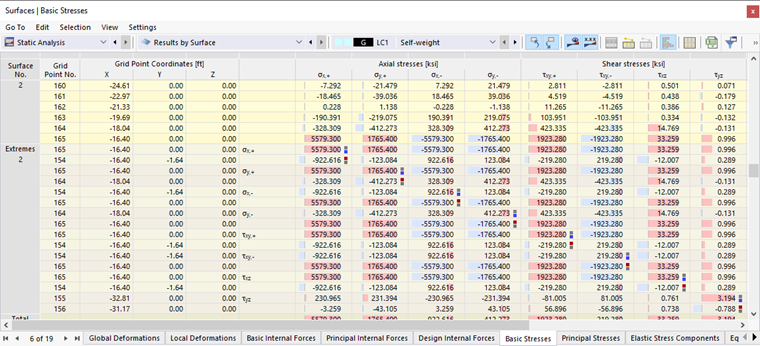In the navigator, define the stresses to be displayed on the surfaces. The table lists the stresses of each surface according to the specifications set in the Result Table Manager .
The surface stresses are subdivided into the following categories:
- Basic Stresses: Stresses in the direction of the surface axes
- Principal Stresses: Stresses in the direction of the principal axes
- Elastic Stress Components: Stresses from moments and axial forces
- Equivalent Stresses: Stresses according to various equivalent stress hypotheses
Basic Stresses
Basic stresses are related to the directions of the local surface axes. When analyzing curved surfaces, they refer to the local axes of finite elements (see the image Displaying FE Axis Systems ).
The basic stresses are shown in the image Surface Internal Forces and Surface Stresses . They have the following meaning:
Principal Stresses
While the basic stresses refer to the xyz coordinate system of a surface, the principal stresses represent the extreme values of the stresses in a surface element. The principal axes 1 (maximum value) and 2 (minimum value) are arranged orthogonally. It is possible to graphically display the principal axis directions α as Trajectories (compare image Displaying Trajectories of Principal Axes ).
The principal stresses are determined from the basic stresses as follows:
Other Stresses / Elastic Stress Components
This category includes stress components due to bending moments and membrane forces. They are related to the directions of the local surface axes. When curved surfaces are analyzed, they refer to the axes of the finite elements.
The bending and membrane stresses have the following meaning:
Equivalent Stresses
The basic stresses are combined according to four equivalent stress hypotheses for the plane stress state.
von Mises
The approach by von Mises is also called "shape modification hypothesis". It is based on the assumption that the material fails when the distortion strain energy exceeds a certain limit. This energy is the type of energy that causes a distortion or deformation of the object. This approach represents the most well-known and most frequently used equivalent stress hypothesis. It is suitable for all materials that are not brittle. Therefore, it is widely used in steel building construction. The von Mises hypothesis is not suitable for hydrostatic stress conditions with equal principal stresses in all directions, as the equivalent stress is zero in such a case.
The equivalent stresses according to von Mises for the plane state of stress have the following meaning:
Tresca
The approach by Tresca is also known as the "maximum shear stress theory". It is assumed that failure is caused by the maximum shear stress. As this hypothesis is especially applicable for brittle materials, it is frequently used in mechanical engineering.
The equivalent stresses according to Tresca are determined as follows:
Rankine
The equivalent stress hypothesis by Rankine is also known as the "maximum principal stress criterion". It is assumed that the maximum principal stress leads to failure.
The equivalent stresses according to Rankine are determined as follows:
Bach
The equivalent stress hypothesis according to Bach is also referred to as the "principal strain hypothesis". It is assumed that failure occurs in the direction of the greatest strain. This statement is similar to the stress analysis according to Rankine. However, the principal strain is used instead of the principal stress in this case.
The equivalent stresses according to Bach are determined as follows:
.png)
